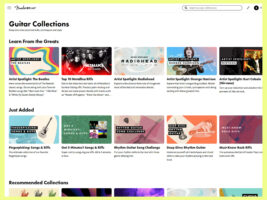
Fender Play review: sleek learning platform is better than ever in 2025
Fender Play! You’ve likely heard of it – it’s one of the most popular learning platforms out there. It was launched in 2017, but thanks to some savvy promotions by Fender it hit the big times across the pandemic. As people collectively realised that 2020 might be the time to dust off that charity-shop guitar and learn some Nirvana songs, Fender offered three months of free lessons via the platform.
READ MORE: Simply Guitar review: simple isn’t always better
The strategy was astute – it drove a huge spike in the size of Fender Play’s userbase, quickly making it one of the most talked-about learning platforms out there. But what is Fender Play like in the post-lockdown world of 2025? Has time been kind to the platform? Is it still a good option for a beginner player? What about someone with a little more experience? I spent several weeks with Fender Play to find out.
Getting started with Fender Play
Fender Play offers a mobile app alongside the browser-based platform. UI-wise, it’s all a pretty unified experience, but for my testing I stick mostly to the browser experience – mainly for screen size reasons. But hey, it’s good to see the flexibility on offer in both directions – apps that offer no desktop version can be just as frustrating as those that are desktop-exclusive.
When I first sign up, I’m given the classic questionnaire – what kind of instrument do I have, what genre am I interested in learning (a choice between rock, pop, blues, country, folk and R&B/soul), and how good am I already. When it comes to my skill level, I do tell Fender Play that I’m able to play across the fretboard (thank you, thank you), but despite this I’m placed at the very start of the Rock Path, and given lessons on how to tune and pluck strings. This makes me think that at least some of the initial questionnaire is not for my sake, but is instead (shock horror) market research.
In any case, I can easily pick a more advanced course – but this is a good opportunity to see what the average beginner will be faced with when they sign up. These early lessons are particularly crucial to the value of a learning tool, as they’re laying down the foundations on which you will build everything else.
Down the path
The bulk of the lessons are housed in Paths, the main superstructures of Fender Play’s library. Each Path consists of different levels (except the ‘essentials’ Path, which is just one level), and each level consists of different courses, and each course consists of different activities. A course will teach either a specific technique, or apply what you’ve learnt so far to a song, and an activity will either be a video lesson or a dynamic tab to hone your skills.
The Path you’re on varies by instrument – acoustic, electric, bass or ukulele, as well as genre. You can change your Path at any time, and select any lesson at any level – although to keep you chugging along a single Path, Fender Play will track your progress and let you easily choose your next lesson when you log in.
What’s immediately clear is that Fender Play’s roster of video presenters is one of its strongest points. For the earlier lessons, the basics are explained patiently and clearly, and the teachers strike a good balance between being comprehensive without overwhelming you with terminology. There’s a lot of presenters, and they’re all skilled players and good instructors.
The tone of the videos is also nice and encouraging, for the most part. Presenters generally seem keen and approachable, without any exhausting and cringey over-enthusiasm – good for diving into an extended learning session without going insane. Things can swing a little too hard in the other direction, though, as every once in a while a presenter will deliver a lesson with the sort of subdued corporate dryness that says “I am just trying to get through what it says on the autocue” more than it does “hey, let’s learn the guitar”. But this is luckily pretty rare, and not too shocking given Fender’s overall video playbook – you rarely see much joking about in its product demos.
Fender Play is also good at establishing a tight loop of ‘learn, play, then reinforce’. While some guitar learning platforms can feel like the sort of video game that only lets you actually play it in 10 minute segments between 45 minute cutscenes (enjoying Death Stranding 2?), Fender Play is instead keen to keep you active and playing along to the teacher as much as possible.
The bulk of the video lessons are followed by smart tab exercises that you can do at your own pace to cement what you’ve learnt. There is also a feedback mode, which works similarly but lets you record your playing for analysis. Whilst the insight gained from automated analysis like this is always going to be limited, I find the idea of playing and then analysing pretty handy. Apps that offer Guitar Hero-style real-time feedback can lead you to concentrate a bit too hard on the app itself while you play – here, you are given the space to do the best performance you can, and then find where you can improve.
Theory will only take you so far
What is also very good to see is the focus on theory essentials as well as guitar essentials, particularly in the early stages. Time signatures and rhythm subdivisions are explained early on, and as mentioned the tabs include traditional rhythm notation as well as a metronome.
While the efficacy of modern, alternative approaches (Yousician’s bouncing ball and so on) is, er, debatable, a mix of traditional rhythm notation and guitar tab is generally agreed to be the best compromise between keeping things legible from a guitar perspective, while remaining musically unambiguous.
And regardless of whether or not those alternative approaches work, what’s true is this: if you stick with the guitar and start playing in bands with other people, tabs and traditional rhythm notation are both going to be understood pretty generally. But if you join a band and need to have your parts notated exclusively in ‘Yousician Bouncing Ball’ format, you might be in trouble.
Simple, but accurate
Given its beginner focus, Fender Play features a good deal of songs that have been simplified for the earlier stages of the Paths. When this has happened, the instructor tells you that the arrangement has been changed, and there’s often a good balance between keeping things recognisable while still communicating the relevant ideas. Simplified riffs are used to draw outlines of concepts, before Fender Play gives you the chance to add detail and colour as you progress throughout the courses.
Take John Lee Hooker’s Boom Boom, which appears very early in the Blues Path – it’s literally the first thing you learn after learning how to fret notes. The version taught gets you playing the second (simpler) part of the song’s call and response, using it to establish how you go about playing a sequence of notes in time, within the framework of a bar of 4/4. And, thanks to the rhythmic tabs ever-present below the video lessons, you’re immediately exposed to how to read quarter notes and rests.
This approach is, I think, a good one – all learning platforms understand that most people pick up the guitar in order to actually play songs, and the sooner that happens the better. However, there is a balance you need to maintain as you do this. Calling these simplified arrangements done and dusted could be more confusing than satisfying, but luckily Fender Play’s teachers explain how a track has been adjusted for learning purposes, and the accurate notation is helpful in seeing how the more basic parts fit together.
As you progress through a Path towards the more intermediate lessons, the arrangements reflect your progress. In the case of rock, metal and other riff-driven music, the transcriptions are accurate to the real thing. In the case of tracks where the original is a more abstract pop arrangement with less of a guitar focus, there are some pretty creative fingerstyle interpretations of the tracks – it’s not always a campfire acoustic version with solely cowboy chords!
More advanced techniques
Fender Play has historically been a pretty beginner-focused platform, and it’s clear that since the lockdown-induced surge of users it’s the early phases of guitar where Fender has put the bulk of its attention. But it’s been half a decade since then – that’s five years of learning for all of those absolute beginners that signed up. So has Fender expanded the ceiling of its learning platform upwards to follow?
In short – it has. Fender Play started out as a platform for just the very basics – however now, there are a good deal of much harder riffs and techniques taught in levels six and seven of each path. The rock path, for example, will eventually have you doing things like the fiddly verse riff of Led Zeppelin’s Bring It On Home and the speedy punk strumming of Green Day.
Beyond the Paths, there are also a few lessons that absolutely transcend the intermediate label, being bonafide ‘advanced’. Not as many as there are beginner lessons, for sure, but for example the solo for Crazy Train is taught, note for note – that’s some serious shredding, and you’ll likely need a good few years of learning under your belt to tackle it. In short, the amount of teaching on offer here is far more than a year’s progress unless you’re taking ten hours of lessons a day – so even if you get an annual subscription, it’s hard to argue that you’re not getting value for money.
Paths and songs aren’t the only way that Fender Play presents its video lessons, either. There are also Skills and Collections, which drill down into specific techniques, or specific sets of songs – things like artist spotlights and collections of famous songs featuring certain techniques are organised into courses that you can progress through, outside of those more structured sections. This is cool to see, particularly as a non-beginner interacting with a platform – it’s a great jumping off point to find ways to broaden your playing horizons.
Learning a song
Fender Play certainly has an impressive song library, and this is arguably one of the platform’s biggest draws – Fender has been able to license a very wide range of music, with a catalogue that includes guitar-driven classics, modern pop, country, R&B, blues, metal and indie rock.
But while simplifying tracks to teach them to beginners is all well and good, this has a bit of a strange effect as on the rest of the experience. Like a few other learning apps, the broader song library will include lessons taken from the wider context of the more structured side of things. When browsing the song library independently of the Paths, you may encounter a track that just happens to be taught as a very early lesson – and perhaps be disappointed when you can’t actually learn the full song.
It’s not all chained to the Paths, though – there are also a few songs that exist as simpler versions within the course, but are presented as more accurate versions within the actual song library. Regardless, it’s still worth noting that just because a song is technically included in the library, it doesn’t mean you’ll be able to learn it in full.
Relatedly, it’s also not guaranteed that a song will have a ‘full’ video lesson where an instructor takes you through each part step-by-step. If you really prefer learning with that kind of granular instruction, it’s meted out a little randomly, and there’s no way to filter for songs that have it. Songs that don’t will instead either have a tabbed-out play along video, or just a dynamic tab. That’s not to say Fender Play’s library of lessons is meagre, not by any stretch – but not all of the 1,200 songs here have a ‘full’ video lesson.
I do also want to note that I run into a couple of technical issues with the ‘practice mode’ tab player every now and again. The worst of these is the occasional audio de-sync, which renders some songs totally unlearnable. This was however very rare and exclusive to the desktop interface – it only affected two tracks across my entire time with Fender Play.
Fender Play, with emphasis on the Fender
Overall my time with Fender play is all very positive. As a learning platform, it’s in excellent shape – this isn’t some lockdown hobby project Fender dumped a load of money into and then abandoned as soon as the pubs opened again, it’s a really solid educational tool that offers great quality teaching and great value for money. However, I do want to address a very Fender thing that comes from Fender Play: While the stated goal is to teach you the guitar, there is always the feeling that there’s another motivation at play here. Rather than a guitarist, Fender Play wants you to be a Fender Guitarist.
It’s undeniable that Fender is good at doing brand things, and not just because you can buy basically any piece of merch you can imagine with a Fender logo slapped onto it. Fender products often feel like they exist within an Apple-styled walled garden, into which no other guitar company may enter. This remains true here: the universe depicted in Fender Play’s video lessons is one where the Telecaster Deluxe is the only dual-humbucker single-cut ever invented, the only metal guitars are Jacksons and Charvels, and the only amps are Fender combos or EVH heads.
Lessons have a “tones” section along with tabs and other info – but rather than general advice on how to get an appropriate tone for the song, this is instead a download link for a Mustang GTX/GT preset. Admittedly handy if you do have either of these amps, and occasionally the instructor does give some more general, less Fender-specific gear advice – but for the most part, gear-focused lessons are about dialling things in on Fender gear.
None of the genuine musical teaching is undermined by this, and I’ve definitely seen more teeth-grindingly profit-driven approaches in educational apps. But it is always there, a background hum of hey, by the way, we also sell everything you can see. This is a strategy Fender has always employed: need an amp, pedal, modeller, guitar (pointy or non-pointy!), audio interface or indeed a learning platform? You can get all of these things and more if you stay within the garden. Please don’t look over the walls. There’s nothing out there!
It is obviously not some searing insight to say that Fender is going to promote its own gear within its own learning platform. But despite the crushing inevitability of businesses needing to make money, it still feels more than a little distracting the more time I spend within Fender Play. I’d rather see beginner guitarists encouraged to explore beyond the big F, as there’s a lot out there – and discovering that whole wide world is as much a part of the guitar journey as learning to play is.
Is Fender Play worth it?
Advertising whinge over, let’s examine the value for money you get with Fender Play. Its base cost is £19.49 a month, or £12.08 a month if you buy annually. This is about average for a learning platform these days – it’s on par with other video library platforms like Guitar Tricks, but it’s a little more expensive than a basic platform like Simply Guitar. The quality of the lessons and the breadth of scope on display, however, are undeniable for the beginner player. It’s a very comprehensive and detailed overview, the kind of thing that can really only be bettered by finding a one-on-one teacher, or finding a bespoke course made by a specific teacher that you resonate with.
For a more intermediate or advanced player, however, Fender Play is perhaps less easy to recommend. It’s still great if you want to go over the basics again to work on the more fundamental aspects of your playing. Don’t expect a lot of super-advanced courses that’ll turn you into some sort of shred god, but there are still a few courses that you may find useful – whether they’re worth it will depend on your approach. There is luckily the option of a free trial, and so with that in mind I would say it’s worth signing up and poking around the platform.
The post Fender Play review: sleek learning platform is better than ever in 2025 appeared first on Guitar.com | All Things Guitar.
Source: www.guitar-bass.net












